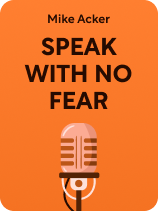

This article is an excerpt from the Shortform book guide to "Speak With No Fear" by Mike Acker. Shortform has the world's best summaries and analyses of books you should be reading.
Like this article? Sign up for a free trial here.
Does public speaking make you nervous? Do you feel like you have to be someone else when you’re in front of an audience?
Public speaker and coach Mike Acker contends that, when you’re giving a speech, it’s important for you to be yourself. Authenticity in public speaking is crucial because it leads you to feel more relaxed and confident. It also makes you appear more trustworthy to your audience.
Read on to discover how embracing your unique style and focusing on your audience can transform your public speaking experience.
Authenticity in Public Speaking
Acker advises that, when you’re giving a speech or presentation, just be yourself. In public speaking, too many people try to imitate the styles, mannerisms, and personas of others instead of being their authentic selves. However, this approach just puts more pressure on them—since they’re now trying to give a performance as well as a speech—which inevitably leads to increased anxiety and a lack of self-confidence.
Instead, strive for authenticity in public speaking. Find and perfect your own intrinsic style. Your unique quirks, physicality, speech patterns, sense of humor, and overall personality are powerful assets when communicating, not flaws to be suppressed or replaced. Embrace them, and you’ll gain much more confidence than you could by imitating someone else.
| Rehearse Your Speech, but Not Your Movements Acker’s third strategy is about authenticity. In addition to helping you relax, authenticity makes you seem more trustworthy—and conversely, if your audience thinks you’re being insincere or “fake,” then they’re less likely to listen to what you have to say. Furthemore, a great deal of how audiences interpret your intentions comes down to your body language, not your words. Some research indicates that natural, unrehearsed gestures often precede conscious thought and speech—in other words, you actually start moving a split second before you’ve decided what to say. Therefore, over-rehearsing specific gestures and other body language elements can make your overall presentation seem artificial. Audience members are likely to pick up on this subtle inauthenticity and decide that you’re not trustworthy, even if they’re not consciously aware of why they feel that way. Therefore, striking the right balance between preparation and authenticity is crucial for a public speaking event. Although rehearsing the content and flow of your speech is important so that you seem confident, make sure to leave yourself some room to be spontaneous with your body language and facial expressions so you also seem honest. |
Supporting Strategy #1: Find a Friend to Speak To
Acker advises you to be yourself when giving a speech, but it’s much easier to be yourself in front of a single friend than a large group of people you don’t know. That’s why his fourth strategy is to find a friend in the audience—or someone you can pretend is your friend—and imagine you’re speaking only to that person.
If possible, mingle with the crowd before your speech. Introduce yourself to a few people, learn their names, and try to form connections with them. Then, when it’s time for you to speak, you can look for those people in the crowd and deliver your speech to them. Doing so will give you some “anchors” in the audience; these people can provide specific places you can focus on so you don’t get overwhelmed by a crowd of strangers.
(Shortform note: This strategy resembles a focus exercise that’s often recommended as a simple, effective way to manage anxiety. The exercise involves clearly and specifically identifying things using each of your senses: taking note of five things you see, four things you feel, three things you hear, and so on. Doing this disrupts your anxious thoughts by forcing you to focus just on the present moment. However, you won’t have time to do the full exercise in the middle of a speech, so identifying specific people in the crowd to focus on can work as an abridged version of it.)
Furthermore, Acker says that your attitude toward your audience will inevitably come through during your speech. If the people intimidate you, they’ll pick up on your nervousness and conclude that you’re not a very good speaker; even worse, they might think that you don’t really know what you’re talking about. On the other hand, if you’re at ease like you would be while talking to a friend, your speech will be much better received.
(Shortform note: As we discussed before, how your audience receives your speech depends a lot on your body language. There are several ways you might be subconsciously telling your audience that you feel uncomfortable or threatened. The most obvious of these signals is folding your arms; it’s a defensive posture that puts a physical barrier (your arms) between you and the person you’re talking to. A more subtle signal is holding tension in your face, especially in your jaw and around your eyes—this gives you an angry or annoyed expression, which your audience will interpret as you being angry or annoyed at them.)
Supporting Strategy #2: Think About Your Audience, Not Yourself
Another major reason you might feel uncomfortable during a speech, and therefore have trouble acting like your natural self, is that you’re too self-conscious. That brings us to Acker’s next strategy: Think about your audience instead of yourself. The more you shift your focus away from yourself, the less anxious you’ll be.
Acker says that you can do this by trying to empathize with the audience. Think about why they’ve come to listen to you—what are they hoping to gain from your speech? Consider what hopes they might have that you could help them fulfill, or what fears they might have that you could assuage. If possible, ask them questions to see what’s on their minds.
For example, if you’re presenting your company’s quarterly sales and profits, your audience is probably hoping for bonuses and afraid of being laid off, so think about how you’ll address those concerns.
Also, to connect with your audience more effectively, observe them while you speak. Periodically check whether they’re paying attention or seem to be getting restless and try to adjust accordingly. If they’re getting bored then it might be time to move to a new topic, break up the monotony with a joke, or wrap up your speech.
| Don’t Try to “Walk a Mile in Their Shoes” You might be tempted to imagine yourself in your audience’s situation in order to generate empathy for them, especially if you’re delivering bad news. However, in her book Atlas of the Heart, social worker Brené Brown says that practice is actually counterproductive to empathy. Brown says that empathy is the ability to truly understand and accept the emotions that another person is experiencing. However, imagining yourself in the other person’s place often backfires because you inevitably bring your own biases, assumptions, and personal experiences into the situation—you start thinking about how you would feel in the same circumstances, instead of how the other person currently feels. The best way to genuinely understand your audience is, as Acker says, to observe them. This will help you to better address their actual needs in that moment, instead of trying to manage feelings that might only exist in your head. |

———End of Preview———
Like what you just read? Read the rest of the world's best book summary and analysis of Mike Acker's "Speak With No Fear" at Shortform.
Here's what you'll find in our full Speak With No Fear summary:
- How to become a confident and compelling speaker
- How to plan for the worst when you’re speaking on stage
- Why people in the US fear public speaking even more than death






